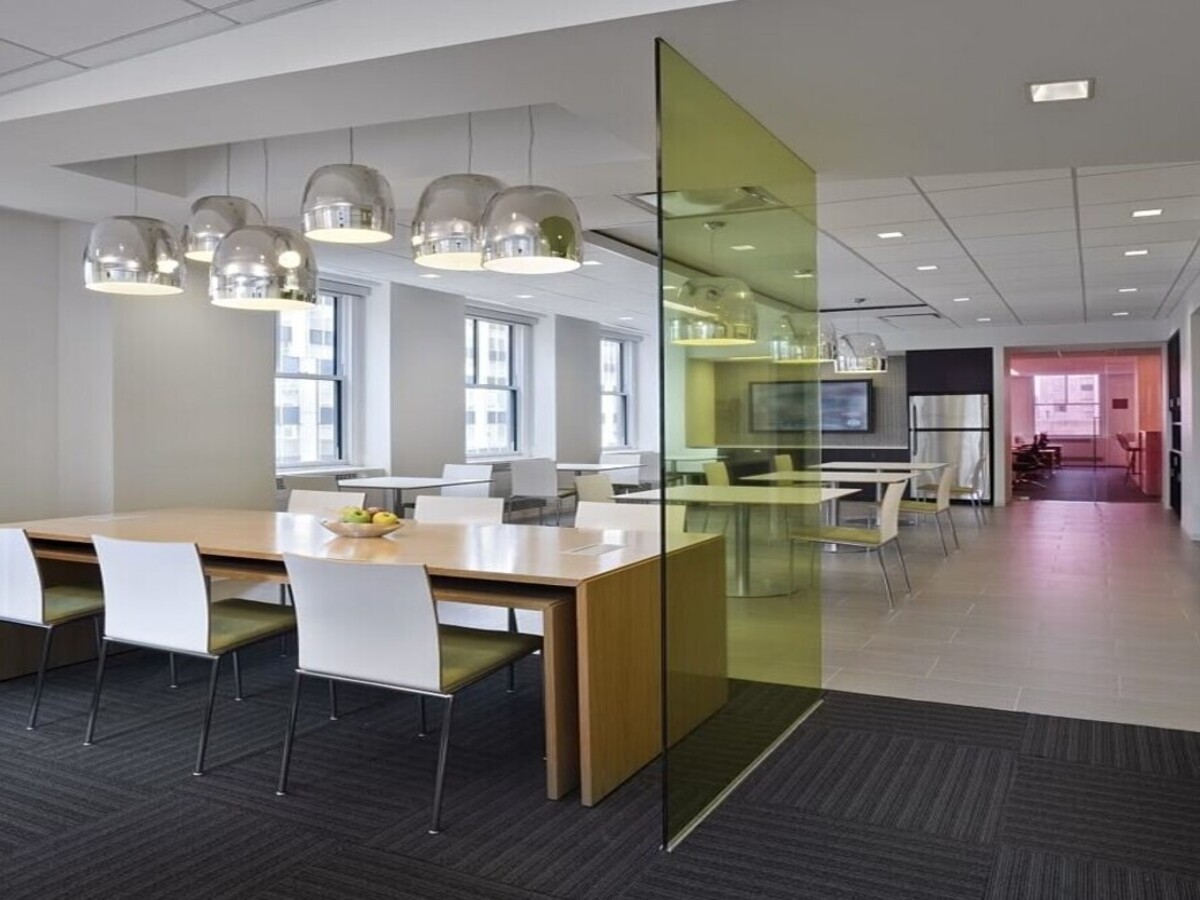
Tinted glass partitions are an excellent choice for creating a distinct separation between spaces while maintaining an open and inviting atmosphere. These glass dividers are treated with a subtle color tint that helps control light transmission, reduce glare, and improve privacy. Unlike clear glass, which provides full visibility, or frosted glass, which completely obscures the view, tinted glass offers a balance; allowing light to pass through while maintaining a degree of privacy.
This guide will cover everything you need to know about tinted glass partitions. You’ll learn about their benefits, the different types available, and how they can be customized to fit your specific needs.
What Are Tinted Glass Partitions?
Tinted glass partitions are glass partitions with a subtle color treatment designed to improve privacy, regulate light, and enhance the overall ambiance of a space. They are commonly used in offices, homes, hotels, and commercial buildings to create defined areas without making spaces feel closed off. The tinting process involves adding a film or using specialized glass that absorbs or reflects certain wavelengths of light, reducing glare and improving comfort.
These partitions come in various shades, from light grays and bronzes to deeper blues and greens, allowing them to complement different interior styles. The degree of tint can be customized based on the level of transparency or privacy required. Some variations even include smart glass technology, which allows users to adjust the opacity with the push of a button.
By incorporating tinted glass partitions, businesses and homeowners can achieve a modern, refined look while maintaining a balance between visibility and discretion. These partitions help in noise reduction, temperature control, and energy savings, making them a practical solution for a range of environments.
How do Tinted Glass Differ from Clear or Frosted Glass
| Feature | Tinted Glass | Clear Glass | Frosted Glass |
|---|---|---|---|
| Transparency | Semi-transparent; reduces glare and brightness while maintaining some visibility. | Fully transparent; allows maximum light and visibility. | Opaque or semi-opaque; obscures visibility while still permitting light to pass through. |
| Light Transmission | Reduces direct sunlight and glare; blocks some UV rays depending on the tint level. | Allows 100% natural light to pass through without obstruction. | Diffuses light, creating a soft glow and eliminating harsh glare. |
| Aesthetics | Comes in various shades like gray, bronze, green, or blue, adding a modern and stylish touch. | Simple and classic; maintains a clean and open aesthetic. | Gives a sleek, elegant, and sophisticated look, often used for decorative purposes. |
| Common Applications | Used in office buildings, sunrooms, and commercial spaces to control glare and heat. | Found in storefronts, display cases, and interior partitions where visibility is crucial. | Ideal for bathrooms, conference rooms, decorative panels, and office partitions for added privacy. |
| Glare Reduction | Significantly reduces glare from sunlight and artificial light sources. | Does not reduce glare intense sunlight can cause discomfort and reflections. | Eliminates direct glare by scattering light evenly across the surface. |
| UV Protection | Can block a significant portion of UV rays (up to 99% with certain coatings), protecting interiors from fading. | Offers no UV protection—prolonged exposure can lead to fading of furniture, flooring, and artworks. | Some UV reduction but not as effective as tinted glass. |
| Durability | Similar to clear glass but can be strengthened with additional coatings for longevity. | Standard durability but susceptible to scratches and breaking. | Durable and resistant to fingerprints and smudges due to its textured surface. |
| Customization Options | Available in different tint intensities and shades. Can be laminated or coated for additional effects. | Limited customization options—mainly available in different thicknesses and sizes. | Can be customized with patterns, gradients, or designs for aesthetic appeal. |
| Cost | Typically more expensive than clear glass but offers long-term savings in energy costs. | The most affordable option among the three. | More expensive than clear glass due to the etching or sandblasting process. |
Benefits of Tinted Glass Partitions
1. Enhanced privacy
One of the biggest advantages of tinted glass partitions is their ability to provide privacy without complete isolation. Unlike solid walls that create a closed-off feeling, tinted glass allows spaces to feel open and connected while limiting direct visibility. This makes them ideal for meeting rooms, executive offices, and shared workspaces where confidentiality is needed but a sense of openness is preferred. Employees can work without distractions while still feeling connected to the larger environment, promoting a balanced and productive workspace.
2. Aesthetic appeal
Tinted glass partitions elevate interior spaces with a sophisticated and contemporary look. Available in a variety of shades, such as gray, bronze, green, and blue, they seamlessly complement different design styles. Whether used in corporate settings, high-end retail stores, or luxury homes, tinted glass adds a refined, upscale feel without requiring extensive renovations. The subtle yet striking appearance of tinted glass makes it a popular choice for architects and designers looking to create modern and visually dynamic interiors.
3. Light control & glare reduction
Harsh sunlight and glare can make working conditions uncomfortable, causing eye strain, screen reflections, and uneven lighting. Tinted glass partitions effectively filter natural light, creating a softer, more diffused glow that enhances comfort and productivity. In office environments, they help reduce glare on computer screens, allowing employees to work more efficiently. Unlike clear glass, which allows unfiltered sunlight to flood a space, tinted glass regulates brightness, ensuring a pleasant and visually balanced atmosphere throughout the day.
4. Energy efficiency
By reducing solar heat gain, tinted glass partitions contribute to a cooler and more energy-efficient environment. Traditional glass allows infrared heat to pass through, increasing indoor temperatures and driving up air conditioning costs. Tinted glass, on the other hand, helps block heat, reducing the reliance on artificial cooling systems. Over time, this leads to lower electricity bills and a reduced carbon footprint. For businesses and homeowners focused on sustainability and cost savings, tinted glass partitions are a smart investment in both comfort and energy efficiency.
5. Versatility
Tinted glass partitions are incredibly versatile, making them suitable for a wide range of applications. In corporate offices, they define spaces while maintaining an open, collaborative feel. In residential interiors, they serve as sleek dividers between living areas, home offices, and dining spaces, adding a modern touch. The hospitality and retail industries also benefit from tinted glass, as it helps create premium, stylish environments in boutiques, hotels, restaurants, and wellness centers. Additionally, healthcare and educational institutions use tinted glass partitions to define spaces while ensuring controlled lighting and visibility where needed.
Types of Tinted Glass Partitions & Their Uses
1. Bronze & grey tinted glass
Bronze glass, with its rich, warm tones, enhances executive offices, boardrooms, and high-end retail spaces, complementing wood and earth-toned interiors. It reduces glare while maintaining a refined and inviting atmosphere.
Grey-tinted glass offers a modern, minimalist look, perfect for corporate offices, conference rooms, and contemporary homes. It subtly enhances privacy while allowing ample natural light, creating a focused yet open environment. Both tints lend an upscale, polished feel, making them ideal for professional and luxury spaces.
2. Blue & green tinted glass
Blue tinted glass is a cool, vibrant touch, ideal for dynamic and wellness-focused environments Blue glass is common in tech offices, creative studios, and healthcare spaces, as its calm, futuristic tone promotes focus and clarity. It also reduces glare, making it great for screen-heavy work areas.
Green tinted glass, inspired by nature and sustainability, suits spas, wellness centers, and eco-conscious offices. It enhances tranquility and relaxation, reinforcing a connection to natural elements. Both tints bring a fresh, energetic aesthetic, helping spaces feel modern, inviting, and productive.
3. Frosted & etched tinted glass
Frosted glass is widely used in private offices, meeting rooms, and upscale residential spaces, offering a soft, diffused finish that obscures direct visibility while keeping areas bright and open.
Etched glass adds decorative patterns, branding elements, or artistic textures, making it perfect for luxury retail stores, boutique hotels, and corporate offices. It allows for privacy while reinforcing brand identity or adding a custom design touch. These glass types blend function and aesthetics, creating refined, semi-private spaces with a high-end feel.
4. Smart switchable glass
Smart switchable glass transitions between transparent and opaque instantly, offering on-demand privacy in premium office spaces, luxury homes, and medical facilities.
In conference rooms, it allows teams to switch between open collaboration and private meetings effortlessly. In healthcare settings, it replaces traditional blinds for improved hygiene and convenience. Beyond privacy, smart glass helps regulate heat and glare, making it an energy-efficient, futuristic solution for modern interiors.
Where Can Tinted Glass Partitions Be Used?
1. Office spaces
Tinted glass partitions are essential in modern offices, allowing for confidential discussions while keeping spaces connected. They are widely used in meeting rooms and private cabins, ensuring a sense of separation without making the environment feel closed off. In open-plan workspaces, they help define individual zones, reducing distractions while still encouraging teamwork. Their ability to reduce glare and control natural light makes them a practical choice for enhancing workplace comfort and efficiency.
2. Homes
In residential spaces, tinted glass partitions create fluid, airy layouts while maintaining separation between different areas. They are commonly used as room dividers, providing a subtle boundary while keeping the space visually open. Shower enclosures benefit from tinted glass by offering a blend of privacy and luxury, enhancing the spa-like feel of modern bathrooms. In kitchens, tinted glass partitions add a contemporary touch, separating cooking areas while allowing natural light to flow through, keeping the space bright and inviting.
3. Retail & hospitality
Stores, hotels, and restaurants use tinted glass to create distinct and functional interiors that reflect their brand identity. Storefronts with tinted glass draw attention while offering a level of privacy that enhances the shopping experience. In hotel lobbies, they add an element of sophistication, subtly dividing lounge areas while preserving an open feel. Restaurants utilize tinted glass partitions to create intimate dining sections, balancing exclusivity with a stylish, modern aesthetic that enhances the overall guest experience.
Design Ideas & Customization Options
1. Framed vs. frameless tinted glass partitions
Framed tinted glass partitions offer structural support and durability, making them ideal for high-traffic spaces like offices and retail stores. The frames, often made from aluminum or steel, add an industrial or classic touch, depending on the finish. Frameless partitions, on the other hand, provide a seamless, modern look, perfect for minimalist interiors where clean lines and openness are a priority. Both options enhance functionality and design, allowing for flexibility in aesthetic preferences.
2. Fixed vs. sliding glass panels
Fixed tinted glass panels create permanent, well-defined spaces, making them ideal for boardrooms, private offices, and home interiors that require structured divisions. They offer sound insulation and stability, ensuring long-term functionality. Sliding glass panels, however, introduce versatility and space efficiency, as they can be opened or closed as needed. Ideal for conference rooms, residential interiors, and hospitality spaces, they allow for easy transitions between private and open layouts.
3. Integration with metal & wooden elements for unique aesthetics
Combining tinted glass with metal or wooden accents elevates the overall design, adding depth and personality to any space. Metal frames in black, brass, or brushed steel create a contemporary or industrial look, while wooden elements bring warmth and a natural touch to the design. This integration is particularly effective in luxury offices, boutique stores, and modern homes.
Factors to Consider Before Installing Tinted Glass Partitions
1. Choosing the right tint for your space
The choice of tint impacts both the visual appeal and functionality of a space. Darker tints like grey and bronze provide a more sophisticated, private atmosphere, ideal for executive offices and meeting rooms. Lighter tints such as blue and green offer a brighter, airy feel, making them suitable for creative workspaces and hospitality settings. The right selection should complement natural lighting, interior design, and the level of privacy needed.
2. Structural and installation requirements
Before installation, it’s essential to assess the load-bearing capacity of walls and flooring to ensure that the glass partitions are securely supported. Framed or frameless designs will influence the installation process, with framed options offering additional reinforcement. If choosing sliding or movable panels, the space must allow for smooth operation without obstructions. A well-planned structural approach guarantees durability, safety, and seamless integration into the overall design.
3. Budget considerations
The cost of tinted glass partitions varies based on glass type, thickness, framing, and additional customizations such as etching or smart technology. While higher-quality glass may require a larger upfront investment, it ensures better durability, insulation, and long-term value.
How to Maintain Tinted Glass Partitions
1. Cleaning techniques to prevent stains and smudges
Regular cleaning is essential to keep tinted glass partitions spotless and streak-free, especially in high-touch areas like offices and retail spaces. Use a soft microfiber cloth or a non-abrasive sponge to gently wipe the surface, preventing scratches that could dull the tint. Always clean in circular or vertical motions to avoid streaks and ensure that no excess moisture seeps into the edges, which can weaken adhesive films over time. A consistent cleaning routine maintains the glass’s pristine look and enhances its longevity.
2. Recommended cleaning solutions
Harsh chemicals like ammonia-based cleaners can degrade the tint over time, leading to discoloration or peeling. Instead, opt for mild, tint-safe solutions, such as a mix of warm water and a few drops of dish soap or a vinegar-based cleaner for a natural alternative. For stubborn stains, isopropyl alcohol can be used sparingly without damaging the tint. Using the right cleaning solutions prevents deterioration and ensures the glass retains its aesthetic appeal for years.
3. Long-term durability and maintenance tips
Beyond regular cleaning, proper handling and preventative care significantly extend the lifespan of tinted glass partitions. Avoid placing sharp or heavy objects directly against the glass to prevent accidental chips or cracks. For sliding or framed partitions, ensure tracks and hinges are kept dust-free to maintain smooth operation. Periodic inspections for scratches, film peeling, or hardware issues help address minor problems before they escalate. Thoughtful maintenance preserves the integrity and functionality of tinted glass, keeping spaces looking elegant and professional.
FAQs
No, tinted glass partitions filter sunlight and reduce glare while still allowing natural light to pass through. Unlike solid walls, they help maintain a bright and open atmosphere. The level of light transmission depends on the tint shade, with lighter tints allowing more illumination and darker tints providing enhanced shading.
Yes, they work well in living areas, bedrooms, and bathrooms, offering privacy without making spaces feel confined. In bathrooms, they serve as stylish shower enclosures, balancing functionality with modern aesthetics. Their versatility allows homeowners to create defined yet visually connected spaces.
Tinted glass provides partial privacy while maintaining visibility, whereas frosted glass offers complete opacity for areas that require full discretion. Tinted glass enhances light control and aesthetics, while frosted glass is preferred for private offices and bathrooms where full privacy is needed.
Yes, tinted glass partitions come in various colors, thicknesses, and finishes, allowing for personalized designs. Options include bronze, grey, blue, or green tints, as well as decorative etching or smart switchable technology. They can also be framed or frameless, fixed or sliding, depending on the space’s needs.
Costs vary based on tint type, customization, and installation complexity. While high-end options with smart technology or decorative finishes are pricier, standard tinted glass remains an affordable and durable investment. Despite the initial cost, they offer long-term style, functionality, and efficiency.













